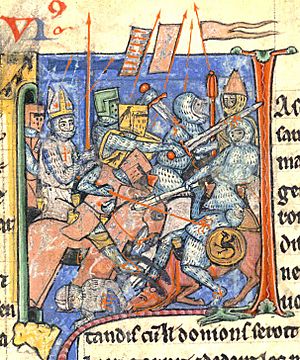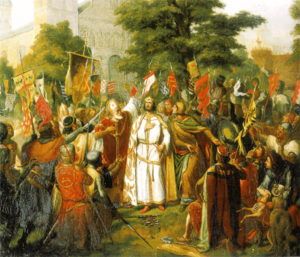Adhemar of Le Puy facts for kids
Quick facts for kids Adhemar of Le Puy |
|
|---|---|
| Bishop of Le Puy-en-Velay | |

A mitred Adhémar de Monteil carrying the Holy Lance in one of the battles of the First Crusade
|
|
| Church | Catholic Church |
| See | Diocese of Le Puy-en-Velay |
| In Office | 1082–1098 |
| Predecessor | Stephan de Polignac |
| Successor | Pons de Tournon |
| Personal details | |
| Born | 1055 Valentinois, Kingdom of France |
| Died | 1 August 1098 (aged 43) Principality of Antioch |
Adhemar de Monteil (died August 1, 1098) was a very important leader during the First Crusade. He was the bishop of Puy-en-Velay, a religious leader in France. Pope Urban II chose him to represent the Church on this big journey to the Holy Land.
Adhemar was known for being brave and a good fighter. He often led knights and soldiers into battle. He fought alongside them in important battles like the Battle of Dorylaeum and the Siege of Antioch. People say he carried the Holy Lance during a key moment at Antioch in 1098. This helped the Crusaders win against a strong army led by Kerbogha. Sadly, Adhemar passed away in 1098 because of an illness.
Contents
Who Was Adhemar of Le Puy?
Adhemar was born around 1045 into a noble family, the Counts of Valentinois. He became the Bishop of Le Puy around 1080. He strongly supported the Gregorian Reform, which was a movement to make the Church stronger and more independent.
Some of his powerful friends included the future Pope Urban II. Another friend was Raymond of Saint-Gilles, who was one of the richest and most powerful noblemen in France. Adhemar had also traveled to Jerusalem on a pilgrimage around 1086. His brother, William Hugh of Monteil, also joined the First Crusade. Adhemar likely met Pope Urban II when the Pope visited Puy in 1095.
Joining the First Crusade
At the Council of Clermont in 1095, Adhemar was very enthusiastic about the idea of a crusade. Pope Urban II had even talked with Adhemar before this big meeting. On November 27, 1095, Pope Urban II chose Adhemar to be the apostolic legate (a special representative of the Pope) and a leader of the crusade. He was chosen partly because he had already made a pilgrimage to Jerusalem.
After the crusade was announced, Adhemar spent a year gathering money and recruiting soldiers. He left on August 15, 1096, and traveled with Raymond of Toulouse and his army. While the other leaders often argued about who was in charge, Adhemar was always seen as the spiritual leader. Most Crusaders respected him greatly.
Challenges on the Journey
During the trip from Durazzo to Constantinople, Adhemar faced some trouble. He was attacked by a group of Pecheneg mercenaries when he wandered too far from the main Crusader army. They beat and robbed him. Luckily, other Crusaders noticed the fight and saved him.
Later, when the army reached Thessalonica, Adhemar became sick. He had to stay there for a while as the rest of the Crusader forces moved on. Eventually, Adhemar was able to rejoin his fellow Crusaders.
Adhemar's Role in the Crusade
Adhemar played a very important role in keeping the Crusaders together.
- He talked with Alexius I Comnenus, the Byzantine Emperor, in Constantinople.
- He helped bring order back among the Crusaders at Nicaea.
- He was crucial in the Battle of Dorylaeum.
- He kept everyone's spirits up during the long Siege of Antioch. He did this by organizing religious events like fasting and special prayers. For example, after an earthquake during the siege, he had the Crusaders fast for three days. He also ordered priests to hold special masses.
- Adhemar also told the Crusaders to shave and wear a cross. This was to help them recognize each other and avoid accidentally fighting their own allies.
After the Crusaders captured the city in June 1098, they were then surrounded by an army led by Kerbogha. Adhemar organized a procession through the streets. He also had the city gates locked. This stopped the Crusaders, who were starting to panic, from leaving the city.
The Holy Lance
During the siege of Antioch, a Crusader named Peter Bartholomew claimed to have found the Holy Lance. This was believed to be the spear that pierced Jesus Christ on the cross. Adhemar was quite doubtful about this discovery. He knew that a similar relic already existed in Constantinople. However, he allowed the Crusader army to believe it was real. This was because it greatly boosted their morale during a very difficult time. A group of Crusaders, led by Henry of Esch, even protected this relic.
Adhemar's Death and Legacy
In June 1098, Adhemar became ill. His condition worsened over the next few months. He died on August 1, 1098, likely from a disease called typhus. Adhemar was buried in Antioch, inside the Basilica of St Peter.
After his death, the leaders of the crusade continued to argue among themselves. This delayed their march to Jerusalem for many months. However, the ordinary soldiers still looked up to Adhemar as their true leader.
Visions After Death
After Adhemar died, some Crusaders reported seeing him in visions.
- Peter Bartholomew claimed Adhemar appeared to him. Adhemar supposedly said that because he had doubted the Holy Lance, he spent some time in a difficult place. He was rescued because a candle was lit for him, he gave a gift to the shrine of the Holy Lance, and because of prayers.
- At the siege of Jerusalem, another Crusader named Peter Desiderius said he had a vision of Adhemar. In this vision, Adhemar told him to have the Crusaders fast and march around the Walls of Jerusalem. They did this, and Jerusalem was captured by the Crusaders in 1099.
- Later, Stephen of Valence also claimed to have visions of Adhemar. Adhemar spoke to Stephen about several holy items. He told Stephen to greatly respect the cross Adhemar had carried on the crusade. He also gave instructions on how the Holy Lance should be treated. Adhemar also told Stephen to give Stephen's ring to Count Raymond, saying it would help Raymond use the power of Mary.
See also
 In Spanish: Ademar de Monteil para niños
In Spanish: Ademar de Monteil para niños


